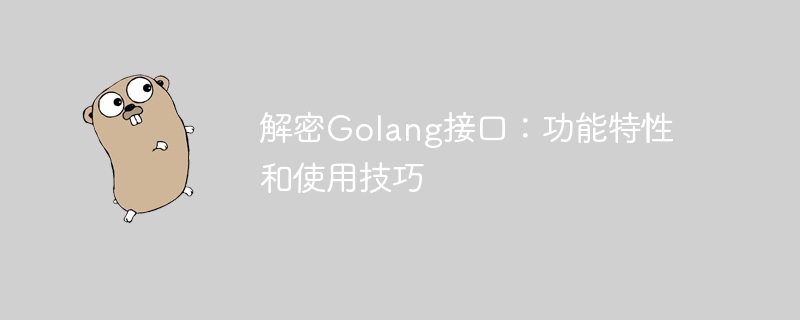Home >Backend Development >Golang >Decrypting the Golang interface: functional features and usage tips
Decrypting the Golang interface: functional features and usage tips
- WBOYWBOYWBOYWBOYWBOYWBOYWBOYWBOYWBOYWBOYWBOYWBOYWBOriginal
- 2024-03-14 08:33:03753browse

Decrypting the Golang interface: functional features and usage skills
Introduction: As an important feature in the Golang programming language, interface (interface) provides a flexible and Powerful way to define contracts between objects. Not only does it enable polymorphism, it also helps code to be better structured and reused. This article will delve into the functional features and usage techniques of Golang interfaces, and illustrate them through specific code examples.
1. Definition and basic concepts of interface
In Golang, an interface is an abstract type defined by a set of method signatures. Any type that implements this set of methods is considered to implement this interface. The definition of the interface is as follows:
type InterfaceName interface {
Method1() returnType1
Method2(argType2) returnType2
// 更多方法定义...
}Among them, InterfaceName is the name of the interface, Method1, Method2, etc. are the definitions of the interface methods, and returnType1, returnType2, etc. are the return types of the methods. An interface defines the behavior of an object regardless of its specific type.
2. Functional characteristics of the interface
- Interface implementation polymorphism: Through variables of the interface type, any object of the type that implements the interface can be referenced. This makes the code more flexible and able to handle different types in a uniform way.
- Interface nesting: Golang allows interfaces to be embedded in other interfaces, thus forming a combination of interfaces. This approach can help the code be better organized and reduce redundancy.
- Empty interface: An empty interface is an interface that does not contain any methods, which is equivalent to the Object type in Java. Can be used to represent objects of any type, similar to dynamic types in dynamically typed languages.
3. Tips for using interfaces
- Clearly define the interface: When designing an interface, you should try to reduce the number of methods in the interface and avoid defining overly complex and redundant interfaces. . The design of the interface should follow the single responsibility principle.
- Assertion of interface: When using variables of interface type, type assertions can be used to determine the actual stored object type, thereby avoiding errors during type conversion.
- Use empty interface: When you need to handle objects of different types, you can use empty interface as parameter type or variable type. When you need to determine the specific type of an object, you can use type assertions to obtain the type information of the object.
4. Code Example
Next, a simple example will be used to illustrate the use of the interface.
package main
import "fmt"
type Shape interface {
Area() float64
}
type Rectangle struct {
Width float64
Height float64
}
func (r Rectangle) Area() float64 {
return r.Width * r.Height
}
type Circle struct {
Radius float64
}
func (c Circle) Area() float64 {
return 3.14 * c.Radius * c.Radius
}
func CalculateArea(shape Shape) {
fmt.Printf("The area of the shape is: %.2f
", shape.Area())
}
func main() {
rectangle := Rectangle{Width: 4, Height: 5}
circle := Circle{Radius: 3}
CalculateArea(rectangle)
CalculateArea(circle)
}In the above example, an interface Shape and two structures Rectangle and Circle are defined, and the Area method is implemented respectively. Through the CalculateArea function, you can calculate the areas of different shapes and output the results.
Conclusion: Through the introduction of this article, I believe that readers will have a deeper understanding of the functional features and usage skills of the Golang interface. As one of the important features in Golang, interfaces can help us better write flexible and reusable code. I hope this article can be helpful to your Golang programming journey.
The above is the detailed content of Decrypting the Golang interface: functional features and usage tips. For more information, please follow other related articles on the PHP Chinese website!

